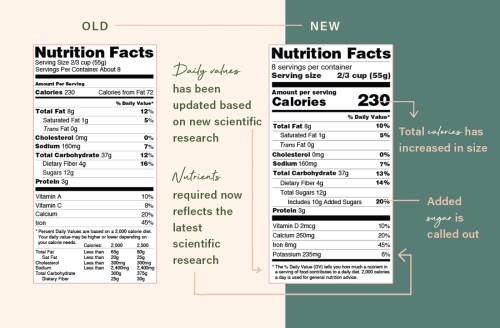Food nutrition labels are getting a big makeover in 2020—here’s what the changes mean for your health
Starting January 1, 2020, food nutrition label changes go into effect. Here, a rep from the FDA and a dietitian explain what they mean.

Walking the aisles of your fave grocery store isn’t all that different from treasure hunting: You have to shift through a fair share of junk to find gems that are both nutritious and delicious. Most healthy eaters know that if you only pay attention to the front of the package, you’re likely to end up with fools’ gold thanks to clever marketing disguised as healthy claims. The real treasure is revealed by reading the nutrition label and ingredients list on the back of the package.
Most of us are pretty familiar at this point with what that nutrition label looks like. But in 2020, you’ll notice that it looks a bit different, thanks to a requirement from the Food and Drug Administration three years ago that is finally going into effect. As of January 1, 2020, all food and (non-alcoholic) drink manufacturers with $10 million or more in annual sales are required to have nutrition panels reflecting the new changes. (Manufacturers with less than $10 million in annual food sales have until January 1, 2021 to comply.) This is the first time the label is being changed since 1993 (!!), and you possibly have already seen some brands update their packaging to reflect the new requirements.
There are 10 total changes between the old nutrition panels and new the new ones, including three biggies that really stand out: total calories are in a bigger font and serving size requirements have changed, added sugar is called out for the first time ever, and the daily value and nutrient requirements have been updated.
Here, a rep from the FDA as well as a registered dietitian explain exactly what these changes mean and how they affect consumers. Are the new nutrition panels new and approved or just new? Keep reading to find out.

Major change one: total calories and serving size
One way brands used to get away with deceiving consumers is making the serving sizes whatever tipped the nutritional facts in their favor. For example, a bottled smoothie with six grams of sugar may not seem so bad on the surface, but if the serving size is only half a cup (and the whole bottle is twice that size), it’s a different story. Now, the FDA is requiring serving sizes to truly reflect what someone is likely to eat when consuming the product.
“The new label features a fresh design and drives consumers’ attention to ‘calories,’ ‘servings’ and the percent Daily Values, three important elements on the label that can assist consumers in making healthier food choices and maintaining healthy weights,” says Claudine Kavanaugh, the director of the office of nutrition and food labeling in FDA’s center for food safety and applied nutrition. “Today, people are eating differently, so label serving sizes were out of date. The FDA’s updated serving size requirements—as well as the number of calories and nutrient amounts corresponding to them—now reflect what people actually eat and drink.”
Registered dietitian Tracy Fox, RD, the president of Food, Nutrition & Policy Consultants, is into these changes. “As more people suffer from chronic conditions like heart disease, high blood pressure, and diabetes, having specific information about what is in the food we eat will be important,” she says. In her opinion, the more info consumers have about what’s in their food the better, and that includes the calories per serving.
Major change two: added sugar is called out
For the first time ever, brands are required to separate added sugar from total sugar. “The Dietary Guidelines for Americans recommend limiting added sugar in the diet. However, consumers did not have a way to determine the amount of added sugars as compared to the naturally occurring sugar in their foods,” Kavanaugh says. “Listing added sugars on the Nutrition Facts label now allows consumers to determine the amount of [added] sugars that they would be adding to their diets when they consume packaged products, and it also allows them to compare these amounts between products.”
Fox has nothing against the update, but says paying attention to the overall total sugar is still what’s most important for consumers to pay attention to. “I think the new label info about added sugar will just show how many products contain sugar, not just obvious ones like candy and cookies, but also condiments, breads, and cereals,” she says.
Other experts worry that the new call-out might be misleading. “Foods made from fruits, whole grains, and dairy can say they have no added sugar because they don’t. … But because they write no added sugar on it, people are unknowingly sabotaging their goals by drinking the entire bottle. Your body can’t differentiate between sources of sugar,” registered dietitian Brigitte Zeitlin, RD, previously told Well+Good.
The takeaway here: keep your eye on the total sugar, which is still what’s most important.
Major change three: updated daily value and nutrient requirements
Even though new scientific data has come out since 1993 reflecting how much of specific nutrients everyone should aim for, the nutrition labels didn’t take it into account. For the first time ever, vitamin D and potassium are listed on nutrition panels, and brands are no longer required to list vitamin A and C.
Additionally, the percentages have been updated, reflecting the latest research on how much of the nutrients listed someone actually needs per day to stay healthy. (For example, daily values for sodium, dietary fiber, and vitamin D have all been updated, based on new scientific evidence from the National Academy of Medicine.) Fox says these are good changes. “This type of label updating should happen regularly as we get more information on the nutritional needs we have,” she says.
While the vast majority of people get enough vitamin A and C, most aren’t getting enough vitamin D, an important nutrient linked to muscle and bone strength. “In the early 1990s, American diets lacked vitamins A and C, but now vitamins A and C deficiencies in the general population are rare,” says Kavanaugh. “Vitamin D and potassium are nutrients Americans don’t always get enough of, according to nationwide food consumption surveys.”
Overall, Fox says a major benefit to all the label changes is that they will likely cause brands to think more about what exactly is in their products. This could lead to reformulating them to be even healthier so that their nutrition panel reflects more of what healthy shoppers are looking for. And more healthier options on shelves is definitely a win. Information is power, and we’re entering 2020 with even more of it.
Here’s the biggest mistake healthy eaters make when reading nutrition labels, according to a dietitian. Plus, all the different types of sugar to look for when eying the ingredients list.
Sign Up for Our Daily Newsletter
Get all the latest in wellness, trends, food, fitness, beauty, and more delivered right to your inbox.
Got it, you've been added to our email list.










